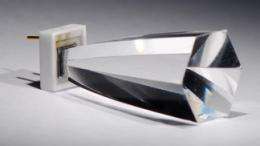© 2011 EPFL
(PhysOrg.com) -- For the first time, a telescope has been equipped with a camera based on a new technology that uses semiconductors. This instrument will observe the flashes of light that are produced by gamma rays when they penetrate the Earth’s atmosphere.
There are particle accelerators in the universe that are far more powerful than CERN’s Large Hadron Collider. Supermassive black holes in the centers of far-off galaxies and the remainders of exploded stars, for example, send various particles, known as cosmic rays, hurtling out into the universe. When these rays interact with interstellar space, they produce another kind of radiation, known as gamma rays. Telescopes observe these particles in order to reveal potential those cosmic accelerators. These telescopes can capture flashes of light, called Cherenkov flashes, that occur when gamma rays interact with the Earth’s atmosphere. The observation of these brief flashes requires ultra-rapid, sensitive cameras that can record several billions images per second. This is the feat that’s been accomplished by the First G-APD Cherenkov Telescope (FACT), designed by EPFL and the universities of Geneva, Dortmund, and Würzburg under the leadership of ETH Zurich.
Getting a glimpse into where cosmic rays are born
Nearly a century has passed since the discovery of cosmic rays, yet their origin remains one of the fundamental unsolved mysteries of modern physics. The FACT telescope is the first step towards solving this mystery, which will involve building a network of Cherenkov telescopes. This network will be crucial for identifying the source of cosmic radiation. Physicists hope to be able to associate the observed flashes with a known object such as a supermassive black hole at the heart of a galaxy or a stellar supernova.
New technology
This is the first time that this semiconductor-based camera technology is being used in astronomy. The FACT telescope detector is composed of light-sensitive diodes that produce an electric current when they record a flash of Cherenkov radiation. The semiconductors are advantageous for several reasons. The camera is lightweight, and so a telescope equipped with it can also be lighter in weight. It maintains good sensitivity in high ambient light conditions. It is thus possible to make observations when the moon is full; the detector’s performance is not compromised by exposure to light, as is quickly the case with traditional cameras.
A 45-person team built the FACT telescope camera on the ETH Zurich campus. Once completed, the detector was sent to the El Roque de los Muchachos observatory in the Canary Islands. It was mounted on an already existing telescope that had been completely restored by a team from EPFL and the universities of Dortmund and Würzburg. Calibration tests and the observations of the first flashes were largely carried out by an EPFL team from the High Energy Physics Laboratory, led by Mathieu Ribordy, who is in charge of for data processing for the telescope. Scientists from the laboratory were able to put to use what they had learned from their participation in the IceCube Neutrino Observatory, an installation in the Antarctic designed to detect high energy cosmic ray neutrinos.
More information:
www.isdc.unige.ch/cta/fact
www.cta-observatory.org/
Provided by Ecole Polytechnique Federale de Lausanne





















